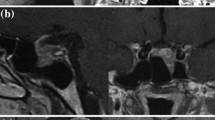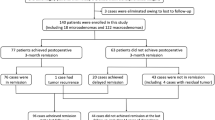Abstract
Growth hormone (GH) pituitary tumors are associated with significant morbidity and mortality. Current treatments, including surgery and medical therapy with somatostatin analogs (SSA), dopamine agonists and/or a GH receptor antagonist, result in disease remission in approximately half of patients. Predictors of GH tumor response to different therapies have been incompletely defined based on histologic subtype, particularly densely (DG) versus sparsely (SG) granulated adenomas. The aim of this study was to examine our own institutional experience with GH adenomas and correlate how subtype related to clinical parameters as well as response to surgery and medical therapies. A retrospective chart review of 101 acromegalic patients operated by a single neurosurgeon was performed. Clinical data were correlated with histologic subtype and disease control, as defined by IGF-1 levels, and random growth hormone levels in response to surgery and/or medical therapies. SG tumors, compared to DG, occurred in younger patients (p = 0.0010), were 3-fold larger (p = 0.0030) but showed no differences in tumor-invasion characteristics (p = 0.12). DG tumors had a higher rate of remission in response to surgery compared to SG, 65.7 vs. 14.3 % (p < 0.0001), as well as to medical therapy with SSAs (68.8 % for DG vs. 28.6 % for SG tumors; p = 0.028). SG tumors not controlled with SSAs consistently responded to a switch to, or addition of, a GH receptor antagonist. Histological GH tumor subtyping implicates a different clinical phenotype and biologic behavior, and provides prognostic significance for surgical success and response to medical therapies.




Similar content being viewed by others
References
S.L. Asa, S. Ezzat, The pathogenesis of pituitary tumors. Annu. Rev. Pathol. 4, 97–126 (2009)
S. Melmed, Acromegaly pathogenesis and treatment. J. Clin. Invest. 119(11), 3189–3202 (2009)
S. Melmed, A. Colao, A. Barkan, M. Molitch, A.B. Grossman, D. Kleinberg, D. Clemmons, P. Chanson, E. Laws, J. Schlechte, M.L. Vance, K. Ho, A. Giustina, Guidelines for acromegaly management: an update. J. Clin. Endocrinol. Metab. 94(5), 1509–1517 (2009)
D.R. Clemmons, K. Chihara, P.U. Freda, K.K. Ho, A. Klibanski, S. Melmed, S.M. Shalet, C.J. Strasburger, P.J. Trainer, M.O. Thorner, Optimizing control of acromegaly: integrating a growth hormone receptor antagonist into the treatment algorithm. J. Clin. Endocrinol. Metab. 88(10), 4759–4767 (2003)
I. Shimon, Z.R. Cohen, Z. Ram, M. Hadani, Transsphenoidal surgery for acromegaly: endocrinological follow-up of 98 patients. Neurosurgery 48(6), 1239–1243 (2001). discussion 1244–1235
I. Donangelo, S. Melmed, Treatment of acromegaly: future. Endocrine 28(1), 123–128 (2005)
P.U. Freda, Somatostatin analogs in acromegaly. J. Clin. Endocrinol. Metab. 87(7), 3013–3018 (2002)
M. Mercado, F. Borges, H. Bouterfa, T.C. Chang, A. Chervin, A.J. Farrall, A. Patocs, S. Petersenn, J. Podoba, M. Safari, J. Wardlaw, A prospective, multicentre study to investigate the efficacy, safety and tolerability of octreotide LAR (long-acting repeatable octreotide) in the primary therapy of patients with acromegaly. Clin. Endocrinol. (Oxf) 66(6), 859–868 (2007)
S. Melmed, D. Cook, J. Schopohl, M.I. Goth, K.S. Lam, J. Marek, Rapid and sustained reduction of serum growth hormone and insulin-like growth factor-1 in patients with acromegaly receiving lanreotide Autogel therapy: a randomized, placebo-controlled, multicenter study with a 52 week open extension. Pituitary 13(1), 18–28 (2010)
M. Buchfelder, S. Schlaffer, M. Droste, K. Mann, B. Saller, K. Brubach, G.K. Stalla, C.J. Strasburger, The German ACROSTUDY: past and present. Eur. J. Endocrinol. 161(Suppl 1), S3–S10 (2009)
A.J. van der Lely, B.M. Biller, T. Brue, M. Buchfelder, E. Ghigo, R. Gomez, J. Hey-Hadavi, F. Lundgren, N. Rajicic, C.J. Strasburger, S.M. Webb, M. Koltowska-Haggstrom, Long-term safety of pegvisomant in patients with acromegaly: comprehensive review of 1288 subjects in ACROSTUDY. J. Clin. Endocrinol. Metab. 97(5), 1589–1597 (2012)
L. Sandret, P. Maison, P. Chanson, Place of cabergoline in acromegaly: a meta-analysis. J. Clin. Endocrinol. Metab. 96(5), 1327–1335 (2011)
M. Marazuela, A. Ramos-Levi, M. Sampedro-Nunez, I. Bernabeu, Cabergoline treatment in acromegaly: pros. Endocrine 46(2), 215–219 (2014)
L. Kasuki, L. Vieira Neto, M.R. Gadelha, Cabergoline treatment in acromegaly: cons. Endocrine 46(2), 220–225 (2014)
P. Nomikos, M. Buchfelder, R. Fahlbusch, The outcome of surgery in 668 patients with acromegaly using current criteria of biochemical ‘cure’. Eur. J. Endocrinol. 152(3), 379–387 (2005)
K. Kovacs, E. Horvath, B. Corenblum, A.M. Sirek, G. Penz, C. Ezrin, Pituitary chromophobe adenomas consisting of prolactin cells: a histologic, immunocytological and electron microscopic study. Virchows Arch. A Pathol. Anat. Histol. 366(2), 113–123 (1975)
E. Horvath, K. Kovacs, Ultrastructural classification of pituitary adenomas. Can. J. Neurol. Sci. 3(1), 9–21 (1976)
S. Yamada, T. Aiba, T. Sano, K. Kovacs, Y. Shishiba, S. Sawano, K. Takada, Growth hormone-producing pituitary adenomas: correlations between clinical characteristics and morphology. Neurosurgery 33(1), 20–27 (1993)
T. Sano, T. Ohshima, S. Yamada, Expression of glycoprotein hormones and intracytoplasmic distribution of cytokeratin in growth hormone-producing pituitary adenomas. Pathol. Res. Pract. 187(5), 530–533 (1991)
A. Obari, T. Sano, K. Ohyama, E. Kudo, Z.R. Qian, A. Yoneda, N. Rayhan, M. Mustafizur Rahman, S. Yamada, Clinicopathological features of growth hormone-producing pituitary adenomas: difference among various types defined by cytokeratin distribution pattern including a transitional form. Endocr. Pathol. 19(2), 82–91 (2008)
P.E. Neumann, J.E. Goldman, D.S. Horoupian, M.A. Hess, Fibrous bodies in growth hormone-secreting adenomas contain cytokeratin filaments. Arch. Pathol. Lab. Med. 109(6), 505–508 (1985)
K. Kiseljak-Vassiliades, S. Shafi, J.M. Kerr, T.L. Phang, B.K. Kleinschmidt-DeMasters, M.E. Wierman, Clinical implications of growth hormone-secreting tumor subtypes. Endocrine 42(1), 18–28 (2012)
V. Karantza, Keratins in health and cancer: more than mere epithelial cell markers. Oncogene 30(2), 127–138 (2011)
G.M. Besser, P. Burman, A.F. Daly, Predictors and rates of treatment-resistant tumor growth in acromegaly. Eur. J. Endocrinol. 153(2), 187–193 (2005)
S. Bhayana, G.L. Booth, S.L. Asa, K. Kovacs, S. Ezzat, The implication of somatotroph adenoma phenotype to somatostatin analog responsiveness in acromegaly. J. Clin. Endocrinol. Metab. 90(11), 6290–6295 (2005)
S. Ezzat, G. Kontogeorgos, D.A. Redelmeier, E. Horvath, A.G. Harris, K. Kovacs, In vivo responsiveness of morphological variants of growth hormone-producing pituitary adenomas to octreotide. Eur. J. Endocrinol. 133(6), 686–690 (1995)
H. Bando, T. Sano, T. Ohshima, C.Y. Zhang, R. Yamasaki, K. Matsumoto, S. Saito, Differences in pathological findings and growth hormone responses in patients with growth hormone-producing pituitary adenoma. Endocrinol. Jpn. 39(4), 355–363 (1992)
P.R. Mazal, T. Czech, R. Sedivy, M. Aichholzer, J. Wanschitz, N. Klupp, H. Budka, Prognostic relevance of intracytoplasmic cytokeratin pattern, hormone expression profile, and cell proliferation in pituitary adenomas of akromegalic patients. Clin. Neuropathol. 20(4), 163–171 (2001)
J. Brzana, C.G. Yedinak, S.H. Gultekin, J.B. Delashaw, M. Fleseriu, Growth hormone granulation pattern and somatostatin receptor subtype 2A correlate with postoperative somatostatin receptor ligand response in acromegaly: a large single center experience. Pituitary 16(4), 490–498 (2013)
Y. Bakhtiar, H. Hirano, K. Arita, S. Yunoue, S. Fujio, A. Tominaga, T. Sakoguchi, K. Sugiyama, K. Kurisu, J. Yasufuku-Takano, K. Takano, Relationship between cytokeratin staining patterns and clinico-pathological features in somatotropinomae. Eur. J. Endocrinol. 163(4), 531–539 (2010)
S.L. Fougner, O. Casar-Borota, A. Heck, J.P. Berg, J. Bollerslev, Adenoma granulation pattern correlates with clinical variables and effect of somatostatin analogue treatment in a large series of patients with acromegaly. Clin. Endocrinol. (Oxf) 76(1), 96–102 (2012)
S. Larkin, R. Reddy, N. Karavitaki, S. Cudlip, J. Wass, O. Ansorge, Granulation pattern, but not GSP or GHR mutation, is associated with clinical characteristics in somatostatin-naive patients with somatotroph adenomas. Eur. J. Endocrinol. 168(4), 491–499 (2013)
S. Melmed, F.F. Casanueva, A. Klibanski, M.D. Bronstein, P. Chanson, S.W. Lamberts, C.J. Strasburger, J.A. Wass, A. Giustina, A consensus on the diagnosis and treatment of acromegaly complications. Pituitary 16(3), 294–302 (2013)
P. Lundin, F. Pedersen, Volume of pituitary macroadenomas: assessment by MRI. J. Comput. Assist. Tomogr. 16(4), 519–528 (1992)
J.D. Carmichael, V.S. Bonert, J.M. Mirocha, S. Melmed, The utility of oral glucose tolerance testing for diagnosis and assessment of treatment outcomes in 166 patients with acromegaly. J. Clin. Endocrinol. Metab. 94(2), 523–527 (2009)
B.M. Mayr, R. Buslei, M. Theodoropoulou, G.K. Stalla, M. Buchfelder, C. Schoefl, Molecular and functional properties of densely and sparsely granulated GH-producing pituitary adenomas. Eur. J. Endocrinol. 169(4), 391–400 (2013)
R. Mori, N. Inoshita, J. Takahashi-Fujigasaki, T. Joki, H. Nishioka, T. Abe, T. Fujii, S. Yamada, Clinicopathological features of growth hormone-producing pituitary adenomas in 242 acromegaly patients: classification according to hormone production and cytokeratin distribution. ISRN Endocrinol. 2013, 723432 (2013)
M. Kato, N. Inoshita, T. Sugiyama, Y. Tani, M. Shichiri, T. Sano, S. Yamada, Y. Hirata, Differential expression of genes related to drug responsiveness between sparsely and densely granulated somatotroph adenomas. Endocr. J. 59(3), 221–228 (2012)
T. Lekva, J.P. Berg, S.L. Fougner, O.K. Olstad, T. Ueland, J. Bollerslev, Gene expression profiling identifies ESRP1 as a potential regulator of epithelial mesenchymal transition in somatotroph adenomas from a large cohort of patients with acromegaly. J. Clin. Endocrinol. Metab. 97(8), E1506–E1514 (2012)
L. Kasuki, L. VieiraNeto, L.E. Wildemberg, L.M. Colli, M. de Castro, C.M. Takiya, M.R. Gadelha, AIP expression in sporadic somatotropinomas is a predictor of the response to octreotide LAR therapy independent of SSTR2 expression. Endocr. Relat. Cancer 19(3), L25–L29 (2012)
V. Nose, S. Ezzat, E. Horvath, K. Kovacs, E.R. Laws, R. Lloyd, M.B. Lopes, S.L. Asa, Protocol for the examination of specimens from patients with primary pituitary tumors. Arch. Pathol. Lab. Med. 135(5), 640–646 (2011)
Acknowledgments
The authors would like to thanks Molly Levitt for help in constructing initial patient database and participation in data collection. This work was supported by Investigator Initiated Grant from Pfizer, Inc and VA Merit Review to MEW, and NIH K12CA086913-12 to KKV.
Disclosures
The authors have nothing to disclose.
Author information
Authors and Affiliations
Corresponding author
Rights and permissions
About this article
Cite this article
Kiseljak-Vassiliades, K., Carlson, N.E., Borges, M.T. et al. Growth hormone tumor histological subtypes predict response to surgical and medical therapy. Endocrine 49, 231–241 (2015). https://doi.org/10.1007/s12020-014-0383-y
Received:
Accepted:
Published:
Issue Date:
DOI: https://doi.org/10.1007/s12020-014-0383-y




